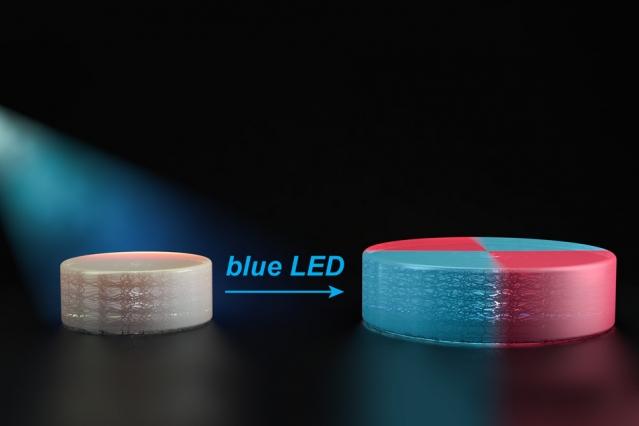 Researchers at the Massachusetts Institute of Technology (MIT) have developed a 3D printing technique which effectively allows users to extend components of a 3D printed object.
Researchers at the Massachusetts Institute of Technology (MIT) have developed a 3D printing technique which effectively allows users to extend components of a 3D printed object.
Traditionally, when an object is created using a 3D printer by placing layers of polymers on top each other, additional layers can’t be extended or adapted by the 3D printed components. In other words, it was previously not possible for a 3D printer user to print an object and then try to make changes to the components of the completed product afterwards.
One of the major factors which disallowed users from extending or fixing completed layers of polymers within a 3D printed object was the rapid development in chemical composition. The composition of chemicals within the polymer layer drastically altered to a completely new form after it was 3D printed and hardened, to a point where researchers described hardened layers as “dead materials.”
MIT researchers studied this particular change in chemical composition within the hardening process of a polymer layer. Based on their observations, researchers then designed specific chemical compositions for a polymer filament and used that to 3D print objects.
The result was the creation of an adaptable polymer layer, which enabled the researchers to make changes to the 3D printed object after its hardening process. The MIT research group was optimistic about the findings of their study and the invention of this newly developed 3D printing technique as it vastly widens the applicability and flexibility of 3D printing technology.
 Researchers further emphasized the importance of the introduction of adaptable 3D printing, as it enables the creation of complex and sophisticated structures, especially for users utilizing 3D printing to create prototypes.
Researchers further emphasized the importance of the introduction of adaptable 3D printing, as it enables the creation of complex and sophisticated structures, especially for users utilizing 3D printing to create prototypes.
“The idea is that you could print a material and subsequently take that material and, using light, morph the material into something else, or grow the material further,” said Jeremiah Johnson, the Firmenich Career Development Associate Professor of Chemistry at MIT.
Initially, Johnson and his team of researchers attempted to use a unique method based on traditional stereolithography to alter the components of a 3D printed object. In 2013, Johnson and his team tried to use a spin off method based on a technique called “living polymerization,” by breaking apart chemical compositions of a polymer layer with the utilization of ultraviolet light.
However, Johnson moved on to research a more efficient and reliable method of adaptable 3D printing as his ultraviolet light-based living polymerization technique imposed significant damage to the material. The possibility of the damage which the technique could cause to an object and the fact that the rapid alteration in chemical compositions is very difficult to control made the technique ineffectual and impractical.
In Johnson’s next project, his team of researchers discovered a “breakthrough” effort as Johnson described, which involved manipulating certain chemical groups that are only reactive to particular catalysts. The major disadvantage of the previous attempt was that the researchers weren’t able to control the reaction of the chemical groups. In this groundbreaking project, Johnson discovered a way to manipulate the chemical compositions of a polymer layer accurately to make extensive changes or improvements to a 3D printed object.
The chemical group manipulated in Johnson’s study is known as TTCs, which are alterable through organic catalysts that are activated by a light source. Specifically, the study revealed that the shining of blue LED light on the organic catalysts attached new monomers to the TTCs, forcing these chemical groups to extend.Cyrille Boyer, an associate professor of chemical engineering at the University of New South Wales, who did not take part in this study, praised the efforts of the team of researchers on using light to catalyze chemical groups. Boyer was especially appreciative of the team’s ability to combine the fields of polymer science and materials science.
Boyer called the work “an inspiring paper for the generation of ‘living’ gels capable to grow and duplicate using visible light and photoredox catalysts. By merging two fields, polymer science and materials science, Johnson and co-workers designed new thermal responsive gels and have overcome the current limitations in the preparation of gels.”
Researchers are optimistic towards the project, as they reported that there exist several catalysts that impose a similar impact on TTCs. Because the particular technique used by Johnson’s team requires a strictly oxygen-free environment, which is difficult to simulate. The team of Johnson will continue to test new catalysts and evaluate their effect on TTCs to see if the activation of alternative catalysts can be more beneficial to the general user base of 3D printing technology.
The team’s results are recorded in a paper entitled “Living Additive Manufacturing: Transformation of Parent Gels into Diversely Functionalized Daughter Gels Made Possible by Visible Light Photoredox Catalysis” published last week in ACS Central Science. Johnson was the senior author, and Mao Chen and Yuwei Gu are the lead authors; additional authors include Awaneesh Singh, Mingjiang Zhong, Alex M. Jordan, Santidan Biswas, LaShanda T. J. Korley, and Anna C. Balazs. Discuss in the Adaptable 3D Printing forum at 3DPB.com.
[Images Via: MIT, ACS Central Science]Subscribe to Our Email Newsletter
Stay up-to-date on all the latest news from the 3D printing industry and receive information and offers from third party vendors.
You May Also Like
Printing Money Episode 17: Recent 3D Printing Deals, with Alex Kingsbury
Printing Money is back with Episode 17! Our host, NewCap Partners‘ Danny Piper, is joined by Alex Kingsbury for this episode, so you can prepare yourself for smart coverage laced...
Insights from Cantor Fitzgerald on AM’s Q1 2024 Landscape
A recent survey by Cantor Fitzgerald sheds light on the persistent challenges within the additive manufacturing (AM) industry in the first quarter of 2024. Based on responses from 38 industry...
3D Printing Financials: Xometry’s Scaling up and Strong Start to 2024
Xometry (Nasdaq: XMTR) kicked off 2024 with strong results, boosting its marketplace and technology to new heights. Both revenue and gross margin soared, fueled by an expanding global network of...
3D Printing Financials: Desktop Metal Targets Recovery Amid Net Losses and Revenue Downturn
Despite facing a decline in revenue and the persistent challenges of a tight economic climate, Desktop Metal (NYSE: DM) is making strides toward operational efficiency. The first quarter of 2024...

































